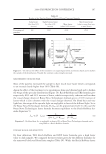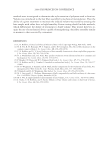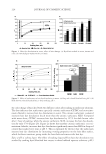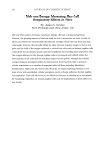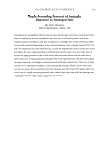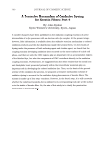JOURNAL OF COSMETIC SCIENCE 200 Raman spectroscopy has been used previously to investigate changes to keratin fi bers after chemical and physical treatments (1–4) and this paper describes two outcomes from a series of preliminary experiments scoping the suitability of the technique to hair fi ber analysis. Consequently, Raman spectroscopy has been applied to obtain baseline measures with the intent of examining the structural phenomena associated with the chemical and physical changes further in a continuing series of experiments. The fi rst objective of this piece of the work was to optimize experimental parameters for spectra quality and collection times of Raman spectra. It is well known that Raman signal intensity of hair should in- crease signifi cantly with a shorter excitation wavelength (3) as Raman signal intensity is proportional to the fourth power of the inverse of the incident wavelength. However, the background luminescence would also be expected to increase signifi cantly with shorter excitation wavelengths (5). Secondly, an investigation has been carried out to determine whether methodologies that have been applied to determine molecular order in commercial polymers can be applied to hair fi bers. The Raman spectra, obtained using a polarized light source, of commercial polymers have been shown to exhibit sensitivity to orientation and this methodology has previously been used to estimate molecular orientation of polypropylene in spun fi bers (6). Similar methods have been applied here. EXPERIMENTAL Virgin yak hair samples were supplied to Avacta Analytical Ltd. (York, UK) for the col- lection of Raman spectra. As in previous work, yak hair has been used as a pigment-free representative model of human hair reducing the problems that are encountered from background fl uorescence. To determine the optimum collection protocol laser wavelengths of 780 nm, 633 nm (red) and 514 nm (green) were selected. A RenishwÒ System 1000 Raman Microspec- trometer was used. The detector slit was set at 15 μm and the binning box to 20 pixels wide. A quarter wave plate was used in the excitation path to make the light incident to the sample approximately circularly polarized to minimize variations in band intensities due to polarization/orientation effects. The fi ber was orientated at no specifi c alignment to the light source. The system was calibrated using a set of emission lines from a neon lamp and the system performance verifi ed using a standard silicon sample. The accuracy of the spectra is within approximately ±1 cm−1. The samples were secured onto a micro- scope slide, which was placed onto the Raman microscope and the surface focused using a 50×, 0.75NA microscope objective. To explore the fi ber orientation characteristics the Raman microspectrometer was set up as described above, though a quarter wave-plate was not used the light incident to the fi ber was therefore linearly polarized. The laser wavelength selected was 780 nm. The fi - ber longitudinal axis was orientated parallel to direction of polarization of the beam and the spectra recorded. The samples were then rotated 90° so that the longitudinal axis was perpendicular to the direction of polarization and further spectra recorded. Though mea- surements were made at different rotations it was ensured that measurements were made at the same position of the fi ber surface. Spectra were recorded using the synchronous scanning mode, covering the spectral range from 200–1700 cm−1 with an exposure time of 60 seconds.
2008 TRI/PRINCETON CONFERENCE 201 RESULTS AND DISCUSSION The laser of wavelength 780 nm was considered as the control for this set of experiments and compared to the spectra obtained at 633 nm (red laser) 514 nm (green laser). The time series spectra for each of three excitation wavelengths are shown in Figures 1, 2 and 3. The analysis performed to determine the most suitable laser wavelength selected for data collection examined a spectral region that has a fl at background level: 1550 cm−1 +/− 10 cm−1. The mean signal intensity at this spectral position was determined and plotted against the integrated exposure time of the fi bers to the excitation laser. This is shown on a log-linear plot in Figure 4. Figure 1. Spectra collected at different time points with 780-nm excitation. Spectra decrease in intensity with increasing excitation time. Figure 2. Spectra collected at different time points with 633-nm excitation. Spectral intensity decreases with increasing exposure time.
Purchased for the exclusive use of nofirst nolast (unknown) From: SCC Media Library & Resource Center (library.scconline.org)














































































